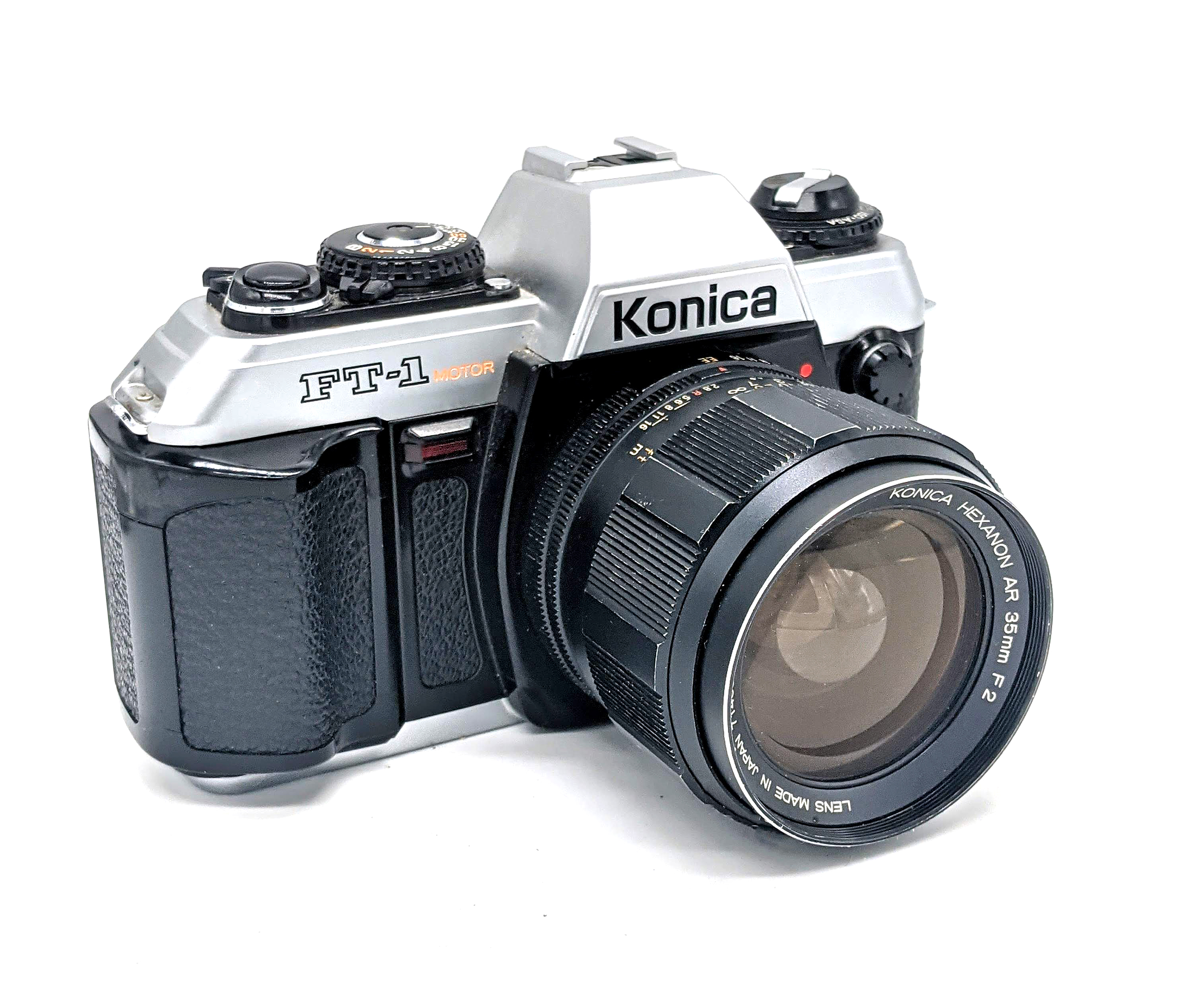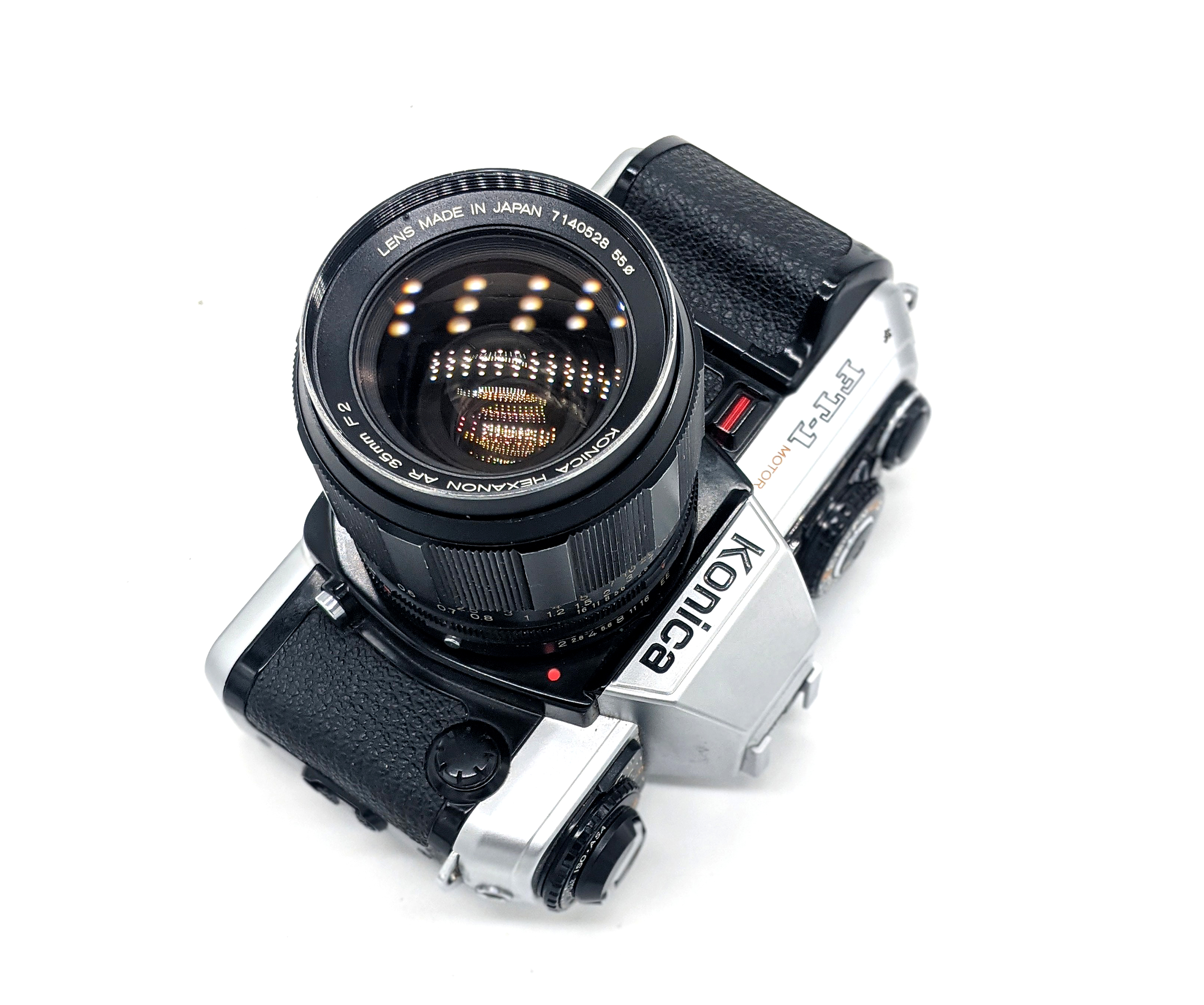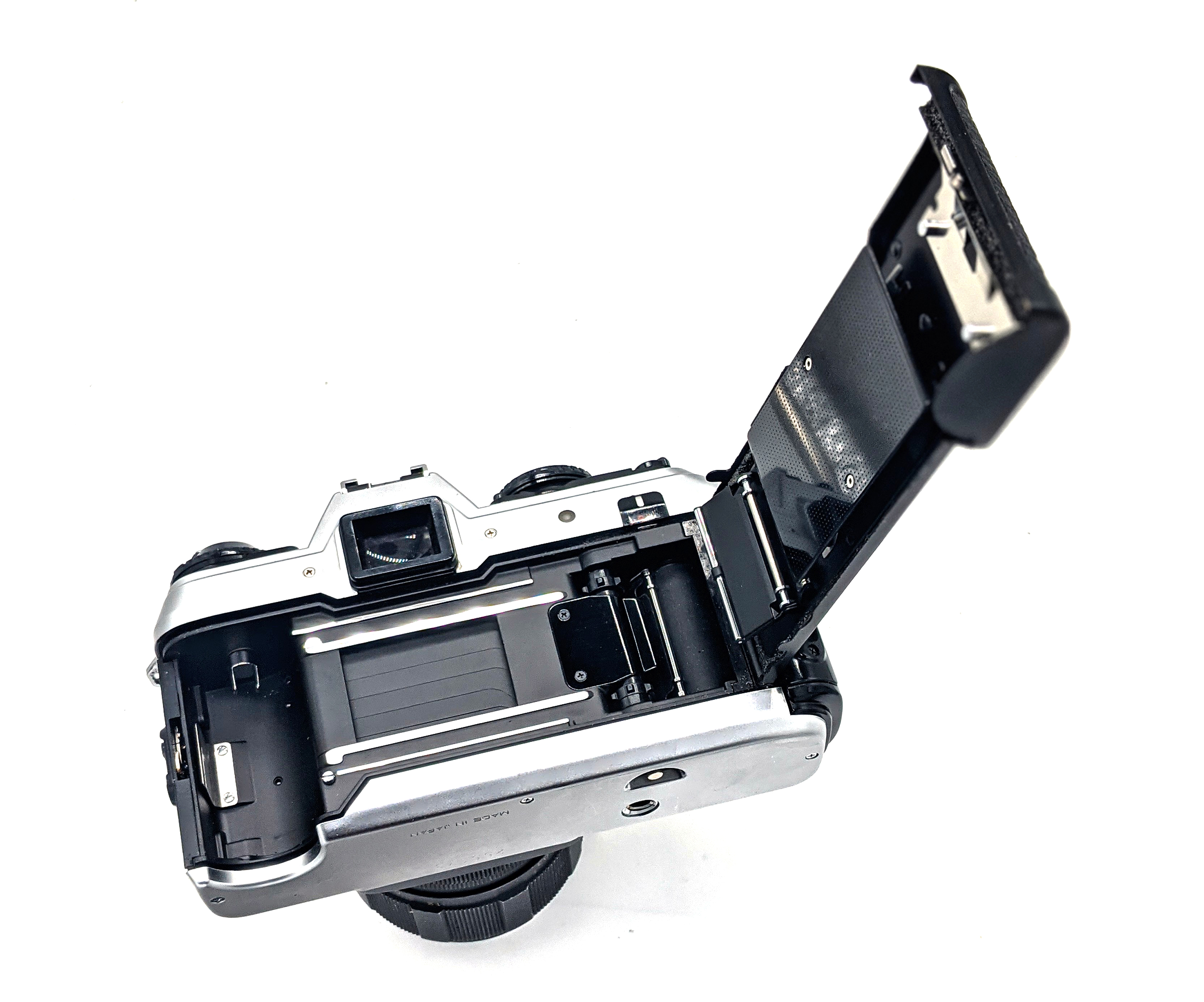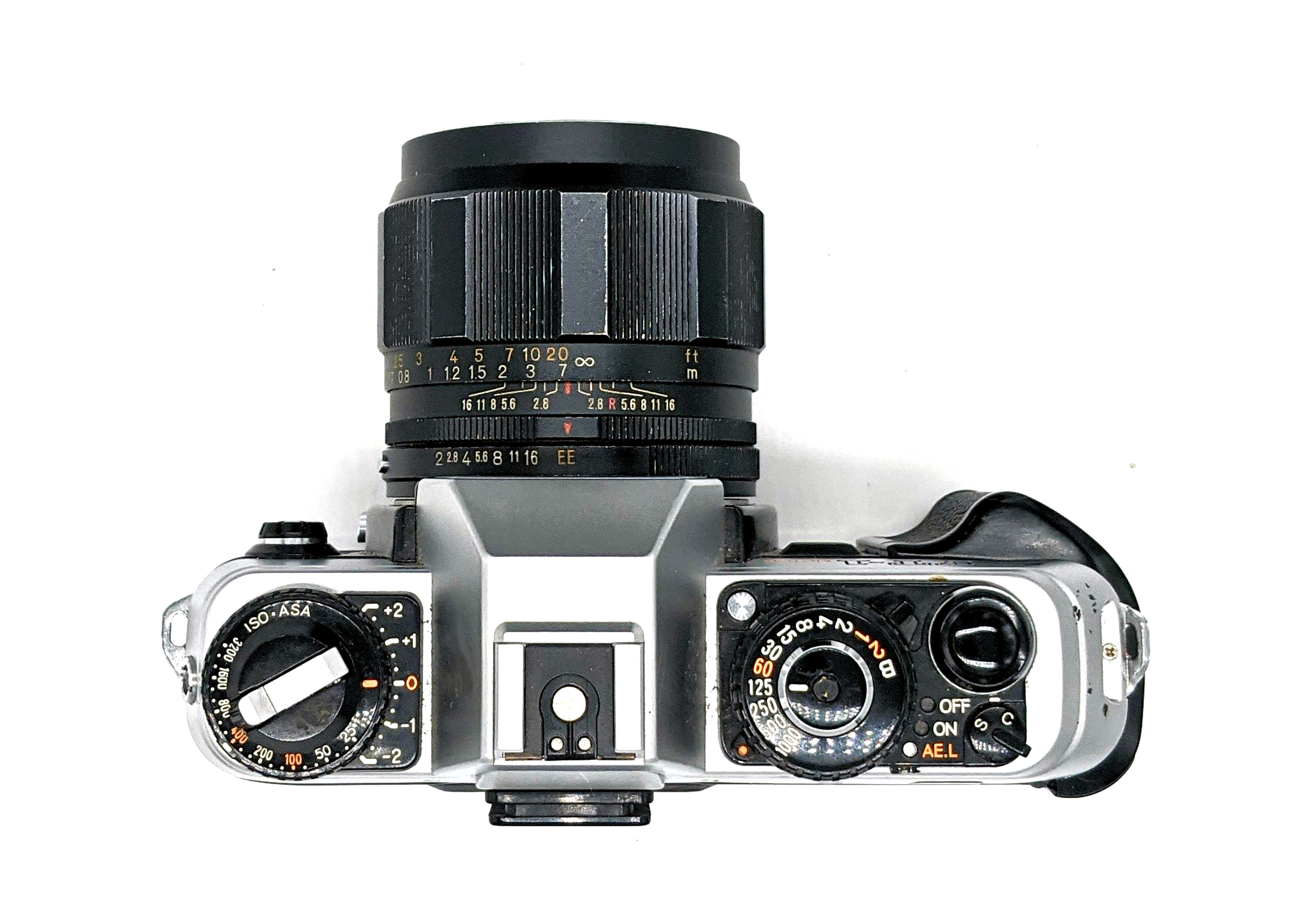
Although not the last new 35mm film SLR introduced by Konica (that would be the 1985 TC-X), the 1983-87 FT-1 was its best. Fixing most of the shortcomings of the abortive 1979 FS-1, the FT-1 incorporated almost all of the features of the better pre-autofocus advanced-amateur cameras of the early 1980s: an integrated motor drive, auto film loading, exposure lock, a relatively bright viewfinder for its class of camera, and the ability to use a dedicated semi-automatic flash system. If looking for an Autoreflex lens mount platform, the FT-1 should be at the top of your list. None of Konica’s contemporary models — the FS-1, FC-1, FP-1, or TC-X — are competitive with it. The FT-1 exists in two versions: a silver and black model. Neither is particularly rare. During its production run, camera stores often bundled the FT-1 with a number of different standard lenses, typically with the Tokina-produced 40mm f/1.8 or 50mm f/1.8 Hexanons or the more expensive Konica-made 50mm f/1.4.
By 1983, with autofocus SLRs on the horizon but not yet to market, electronic-shutter, battery-dependent cameras had come to dominate the market. 1983 witnessed the introduction of a number of remarkable cameras such as the Nikon FE2 & FA, the Canon T50, and the Minolta X-500/570. With competition in the professional and advanced amateur markets so intense, slight differences in price or the addition/omission of a single feature could make or break a new model. The FT-1’s biggest selling points were: (1) an integrated film loading and advance (which was still quite rare in 1983); (2) an intuitive easy-to-use exposure lock located by half-depressing the shutter button (many cameras of the era either did not have AE Lock, had external switches and levers to lock the exposure, or just had an external “back-lighting” button); and (3) an ability to use dedicated, semi-automatic flashes at a slightly-higher sync speed. Otherwise, with a top speed of only 1/1000 (average for the class), and the lack of accessories like focusing screens, battery packs, and the like, the FT-1 was no professional machine.
In terms of reliability, the FT-1’s electronics have held up “fairly” well. Its primary and endemic problem is its gasket deterioration. In essence, the gaskets used between the circuit strips eventually broke down into sticky piles of goo whose residue interferes with the electrical contacts. Thankfully, dedicated camera enthusiasts have developed step-by-step tutorials for the relatively-painless (i.e., still relatively) fix, which requires some disassembly of the top of the camera, the cleaning of the old goo, and the replacement of the gaskets with common household materials. This operation will probably be necessary for nearly any FT-1 still in existence. If it helps, I am not great at camera repair, but I was able to do it.
So, with all of that, let’s take a look at the swansong of the Konica SLR line.

Specifications
| Lens Mount | Autoreflex |
| Exposure Modes | Shutter Speed Priority / Manual |
| Shutter | Vertical Electronic Metal Focal Plane |
| X-Sync | 1/100 (Dedicated Flash) or 1/60 (Other) |
| Viewfinder Coverage | 92% |
| Meter | Center-Weighted Silicon Diode |
| ASA Range | 25-3200 |
| Shutter Speed Range | B, 2 secs – 1/1000 |
| Weight | 570g |
| Batteries | 4 x AAA or 4 x AA |

Operation
The FT-1 is a straightforward and easy-to-use camera.
Motor Drive: The number one selling point of the FT-1 at launch was its integrated film loading and advance Film loading is straightforward. Pull the film across the plane and close the film door. On the “single” shooting mode, the FT-1 may get up to 1 frame per second, but “continuous” could possibly (optimistically?) do up to 2 frames per second. The motor drive is not necessarily quiet, but significantly quieter than the external motor drives of the day.
Exposure Lock: Konica’s prior Autoreflex cameras each were able to “exposure lock” through a half-depress of the shutter button. To activate exposure lock on the FT-1, you slide the lever around the shutter button to the AE-L position and half-depress and hold the shutter button.
Shutter Speed Priority: In 1968, Konica was first-to-market with an SLR with shutter-speed priority autoexposure with its Autoreflex T. Although aperture-priority operation eventually became more popular and widespread on other manufacturers’ SLRs, shutter speed priority is no less difficult to deal with. A main advantage of shutter speed priority is to ensure that the speed is always high enough to prevent motion blur, the death-knell of any photograph. By keeping the shutter speed at a minimum of 1/60 and only moving up from there, motion blur risks are minimized. Konica bodies require the lens be set to “EE” or “AE” for the autoexposure to operate properly.
Metered Manual Mode: Like other Konica AR bodies, the FT-1 will meter in “manual mode.” In essence, you select a shutter speed and aperture and when the LED illuminates in the blank spot in the viewfinder right above f/1.4, you are at the right settings.
Flash Technology: TTL flash operation hit the market around 1980. TTL flash meant that now the camera is the device that measures the reflected light from the subject to determine the proper exposure. TTL flash operation (requiring dedicated units) began to appear on cameras like the 1981 Minolta X-700 and the 1982 Nikon FG. The FT-1 does not have TTL flash capability. However, Konica’s dedicated X-24 and X-36 flashes will automatically set the shutter speed on the FS-1, FC-1, and FT-1 to a higher X-sync (1/100 instead of 1/60) and then automatically set the lens aperture to that setting indicated on the switch of the flash. In theory, this is slightly more automated than a regular auto flash where one would have to set the shutter to 1/60 and set the appropriate aperture on the lens, the Konica flash units were not particularly versatile with the X-24 having only two aperture settings (f/5.6 and f/11). Of course, the FT-1 will work with virtually any third-party auto mode flash.
Viewfinder: The FT-1’s 92% coverage and 0.81x magnification are just about average for cameras of the class. Of course, viewfinder brightness will most always be dependent on the maximum aperture of the lens you are using. Although the viewfinder is bright, certainly good enough to easily focus indoors with lenses with a max aperture of f/2 and wider, it is certainly not “professionally” bright. However, the FT-1 is much better than all Konica AR bodies that came before it. The non-interchangeable focusing screen is a standard split image micro-diaprism. The actual display is borrowed from the FC-1 and uses LED lights that are illuminated next to the aperture selected for the shutter speed from f/1.4 to f/22. Overexposure is indicated by f/22 blinking and underexposure by a blinking light in the blank slot above f/1.4.

Batteries: The FT-1 came standard with a four-slot AAA battery pack that was advertised to be good only for about 20 rolls. The more desirable optional AA battery pack had a larger capacity for about 40 rolls. Konica warns not to use NiCad batteries in the camera. However, rechargeable NiMH batteries work just fine.
Self-Timer: The button is located on the top of the camera by the shutter speed dial.
Exposure Compensation: On the left side of the camera, the FT-1 has a dial for -2 to +2 exposure compensation in 1/3 stop increments.
Use of Exakta, M42 & Nikon Lenses: Like all Konica AR bodies, it is possible to use with full infinity focusing and metering M42, Exakta, and Nikon F lenses with the appropriate adapter. However, although AR bodies will meter these lenses, using them is a bit cumbersome.

Compared to Its Model Year 1983 Competition
When compared to its direct competition at similar price points, the FT-1 presented an attractive options. The cameras below all sold with a standard lens for about $175-225 in 1983.
| Konica FT-1 | Canon T50 | Minolta X-570 | Nikon FG | Yashica FX-70 | |
| AE Modes | Shutter | Program | Aperture | Program & Aperture | Aperture |
| Shutter | Electronic Metal Vertical | Electronic Metal Vertical | Electronic Metal Horizonal | Electronic Metal Vertical | Electronic Metal Vertical |
| Shutter Speeds | 2 sec – 1/1000 | 2 sec – 1/1000 | 1 sec – 1/1000 | 1 sec to 1/1000 | 11 sec – 1/1000 |
| Meter | Center-Weighted Silicon Diode | Center-Weighted Silicon Diode | Center-Weighted Silicon Diode | Center-Weighted Silicon Diode | Center-Weighted Silicon Diode |
| X-Sync | 1/60 or 1/100 | 1/60 | 1/60 | 1/90 | 1/100 |
| TTL Flash | No | No | Yes | Yes | No |
| Viewfinder Coverage | 92% / 0.81x | 92% / 0.83x | 95% / 0.90x | 92% / 0.84x | 95% / 0.86x |
| ASA Range | 25-3200 | 25-1600 | 12-3200 | 12-3200 | 25-1600 |
| Motor Drive | Load / Advance | Load / Advance | Motor Drive 1 | MD-14 | No |
| Exposure Lock | Yes | No | Yes | No (Backlight Button) | Yes |
| Weight | 570g | 490g | 480g | 490g | 435g |
| Batteries | 4 x AAA or AA | 2 x AA | 2 x SR44 | 2 x SR44 | 2 x SR44 |
Conclusions
If you enjoy using Konica AR lenses for film photography, you are pretty much stuck with Konica bodies because of their lens’ close film-to-flange distance. In my view, the FT-1 is the best option. While many Konica aficionados would alternatively suggest the bulky and mechanical 1973 Konica Autoreflex T3, I am generally not a fan of that generation of SLRs. With the brightest viewfinder and the best feature set, the FT-1 remains Konica’s best overall SLR and is a great platform for using Autoreflex lenses on film.
Vilken noggrann samt informativ historia.
Har en FT 1 Motor och kört några rullar igenom den.
Lite svårt att förstå ljusmätaren, så tack för infon.
Har även just köpt en Konica Hexagon Ar 50mm F1,4.
Hoppas på fina foton med denna.